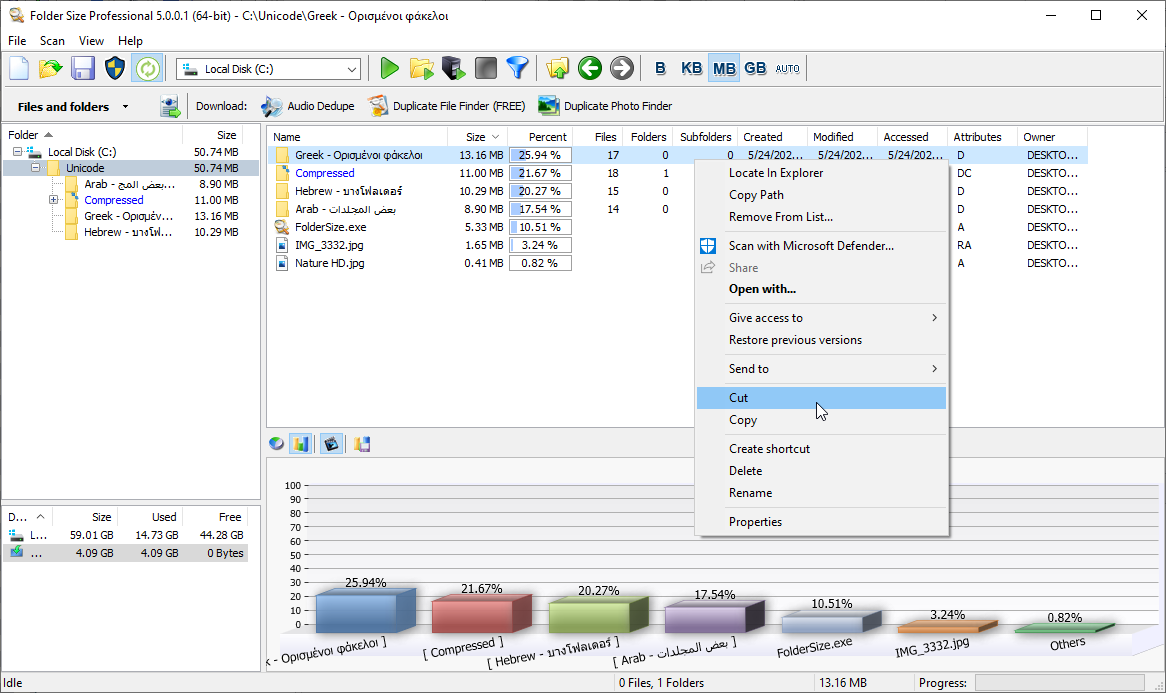
Windows Explorer is the core file management application in Windows. It lacks very useful information though - the Folder Sizes Column. There are several ways that you can display folder sizes in Explorer, but there is a better and free way to do it.
We will get into deeper details on how to display folder sizes in windows explorer further below. While those methods will help to inspect directory sizes, the FREE Folder Size application can do it much faster and easier. It is the best and easiest way to view folder sizes in Windows.
In addition to displaying all folder sizes, it can also list largest fails and largest folders. Find empty files and folders, list longest file names and paths, print folders tree, print files list, visualize disk space in neat pie and bar charts. It can view hidden backup folders and all hidden system files. Locate space hogs and recover lost disk space easily.
Folder Size is a FREE tool that looks similar to Windows Explorer and will not only list the folder sizes, but it can also list the largest folders and files in your system in order to easily organize the disk space. While it may look inconvenient to use a separate application for that, it is easily accessible from Windows Explorer via the "Scan with Folder Size" menu. It is the best option that you have. If you insist on having the folder sizes listed inside File Explorer in Windows please read ahead.

Folder Size adds a context menu item inside Windows Explorer. You can right-click any folder and select "Scan with Folder Sizes". That will list its size and that of all its sub-folders and files. If a copy of Folder Size is already running you can drag-drop a folder from Windows Explorer inside it to scan.
Listing the folder sizes is the least that the tool can do. There are many reports and options that will help you to organize the drive space. The "Largest Folder" and "Largest Files" reports will display the corresponding information for the currently selected folder and all its sub-folders.
Options to print folders and files and also their sizes are included too. The lists can be printed in many popular formats like PDF and TIFF as well as on paper.
There are beautiful pie and bar charts that make it easy to spot space hogs instantly. You can free up gigabytes of wasted space in just a few minutes. Use the reports and you will be able to find large files and folders that you have not used for ages. Remove them to recover disk space and improve the performance of your system.

Enough about Folder Size - just download and try it. The tool is so easy to use that you do not need to read help files and user manuals. Now let's move to the interesting question and specifically:
While it may look very strange and unpractical, there are many reasons for that. First of all, that information is not contained in the file system. Unlike the files that have a size property, the size of the folder is not important for the proper operation of the system.
The file system is the underlying structure that holds information about the files and folders. That structure is often referred to as FAT. (File Allocation System) It is managed and maintained by the operating system. In order for the operating system to quickly display folder sizes the information has to be stored in the FAT.
There are hundreds or even thousands of files that are modified in your system every second. These are not the files that you are currently working on like documents, photos, or other personal files. These are internal files that are used by the operating system and the applications, needed for their core functionality. Now let's imagine for a second what we need to do in order to constantly monitor the folder sizes. All file modifications will have to be monitored and every increase and decrease of a file's size has to be written to the FAT. This information has to be written to the folder that contains the file and also to all parent folders that contain the folder where it is located.
As you can understand this will dramatically impact the performance of the file system and also the operating system. Such an impact can not be justified for a feature that is not important for the normal operation of the system. What would you prefer? A fast system that is missing folder sizes or a slow system that includes a feature that you do not need all the time.
Folder Size on the other hand runs only when you need it and scans only the folders that you want to analyze. That is why it will not have negative impact on your system. The tool does not run in the background. You launch it by clicking the "Scan with Folder Size" Windows Explorer context menu.
Multiple writes to the file system reduce the life of the storage. This is especially true for modern SSD drives where the number of write operations is limited. Writing the change to the size of a file and folder and propagating it to all parents will have a very negative impact on the drive's lifespan. Such sacrifice is really not justified for information that can be propagated and calculated on demand.
Again using the Explorer Folder Size context menu that our tool adds will keep your storage healthy. This is because the tool scans and displays the data only when you need it. It does not constantly monitor all file operations and it does not constantly recalculate and write folder sizes to the file system. It will only READ and calculate such information when it is necessary and will not write anything to your drives during the scan. Of course, you can save or export the folder size information after the scan is completed.
The file allocation table holds the bare minimum data needed to properly operate with the files and folders. Even the smallest increase in the size of that structure has a huge impact on the wasted space. If we add a single byte to the file/folder structure it impacts all the items in the FAT. Therefore it will be multiplied by the count of all the files and folders. That is why adding a folder size field that can be calculated from the already available data is not justified. A proper implementation would need at least 8 bytes per folder. If we need to add that to a drive with 1 million folders it will cost 8 million bytes.
Using the Folder Size Explorer context menu to calculate the folder sizes on demand solves both the redundancy and data integrity issues. As noted above the tool does not write anything to the system during the scan process. This means that it can not suffer from redundancy or data integrity issues. If a power failure occurs during the scan the only thing you need to do after restarting your computer is to run a new scan. As only READ operations are performed even if you kill the tool during the scan it will not cause issues with the file system.
The other problem with the display of folder sizes is data integrity. All the core file system operations are designed to be performed as fast as possible. This is important in order to keep the file system in a healthy state. If a modification to the file system requires too many operations a failure in one of them may leave the system in an erroneous state. Let's imagine that we have to keep information about every folder size. This means that if a file is resized we have to update the data of every parent folder that includes it. Now if a system crash or power outage occurs this process will be interrupted. As a result, many folders will have incorrect sizes. We already commented in the performance section that thousands of files are modified every second.
What has to happen in this case is that when the operating system starts the folder sizes have to be recalculated which may require a lot of time on large volumes and slow drives.
As you can see, while it would be great to have the folder sizes listed in Windows Explorer the drawbacks are much more than the benefits. I personally would love to see the data integrated into Windows Explorer, but would not sacrifice the performance of my system or the life of my storage device. Maybe in the future, a new method of storing data will be developed that will make it easy to store folder size, but at this point, it is not a task that is worth the drawbacks.
Windows Explorer probably is the most used application in the operating system. It provides many features that make it easy to work with files and folders. Along with the local drives, this also includes network locations and external storage. There are many ways to view the folder sizes in Explorer. We will take a look at them and analyze their practicality.
The context menu is the menu that appears when you right-click an item. Right-clicking a folder item provides a pop-up menu entry named "Properties". When you select "Properties", Windows Explorer displays the folder properties and at the same time starts to calculate its size. This usually is sufficient for viewing a folder's size, but you have to do this on every folder that you want to examine. The other small annoyance about the feature is that it does not display when the operation is completed. Sometimes it stays a long time without updating the size and you can assume that it has finished before it ends.
Another option is to hover over a folder and a tooltip is displayed with the folder's size. Of course, this is not any faster than using the "Properties" menu. Actually, it works only on smaller folders and may cause problems in network locations. Though it seems more convenient, it may not always be accurate. This makes it something that can not be relied on.
As we discussed earlier the folder sizes are a feature of the file allocation system. Currently, there are no common file systems that implement such features. All contemporary operating systems rely on similar methods like in Windows to calculate and display Folder Sizes. There are many external tools like Folder Size for Linux and macOS. As of now Folder Size support only Windows.
Folder Size is FREE and will solve the problem of missing folder sizes in Windows Explorer.
Applies to: